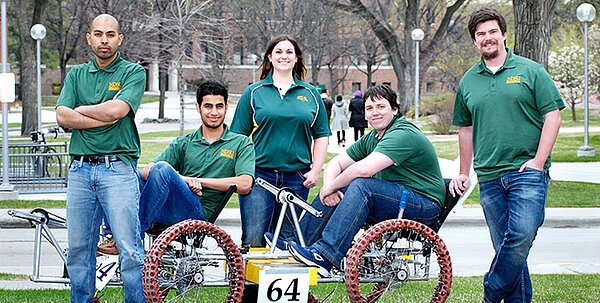
Students pull together years of education for NASA competition
Published April 28, 2015
A group of NDSU students raced through simulated moonscapes and Martian craters during the annual NASA Human Exploration Rover Challenge at the U.S. Space and Rocket Center in Huntsville, Alabama, in April. They had to pull together everything they’ve learned in the mechanical engineering program to get there.
The NDSU team was among 95 high school, college and university squads from around the world who raced in the April. Participating teams were from 15 U.S. states, Puerto Rico, Mexico, Germany, India and Russia.
Kartik Joon, Nabin Karki, Andrew Norris and Joe Rogers designed, built and raced the NDSU vehicle to fulfill the requirements for their Capstone Senior Design Project. Amanda Sys joined the team for the competition.
For capstone projects, students apply what they have learned from their first freshman course through their final semesters to a real-world challenge. Projects are evaluated on design, material and mechanism selection, implementation and presentation, and the final products needs to be in line with applicable codes and standards while meeting budget and timing restrictions.

An NDSU team of seniors in mechanical engineering designed, built and raced a moon rover for their final project. In the process, they applied everything they learned in the program.
“Everything in our classes built up to this,” Rogers said. “Sometimes we’d have to go back to the first building block, sometimes we’d have to go to the last block, but all the way through there was something we learned that we could apply to this.”
The two-day challenge required student teams to design and manufacture two-person, human-powered rovers and race them through a three-quarter-mile course with 17 lunar-type and Martian-themed obstacles that highlighted NASA’s journey to Mars and other deep space exploration.
“There was a size constraint and there were a lot of rules regarding the wheels, but outside of that you have two people racing, this is the course, go for it,” Rogers said. “It was interesting to see just how many different ways there are to meet those constraints and twist them into your own design. Yeah, we might of thought of something this way, but that team thought of it this other way and that works, too.”
The obstacles were carefully shaped to resemble craters, basins, boulders, ancient lava flows and crevasses. The course also featured simulated asteroid debris, with boulders from 5 to 15 inches across, an ancient stream bed filled with pebbles about 6 inches deep and erosion ruts and crevasses in varying widths and depths. Two-person crews raced the vehicles against the clock for the fastest times and vied for awards in categories such as best rookie team, technology design and systems safety.
It was tough terrain, and on the first day a weld broke on the NDSU rover. The second day brought more trouble when one side of the driveshaft came off.
It was a valuable lesson of the capstone project: in rover challenges, as in life, there will be setbacks. Another was that it takes the whole team to get the job done.
There was no way the NDSU rover could have completed the race, so the three NDSU team members on the sidelines made their way onto the course to join the two drivers. The entire team carried their rover over the finish line.